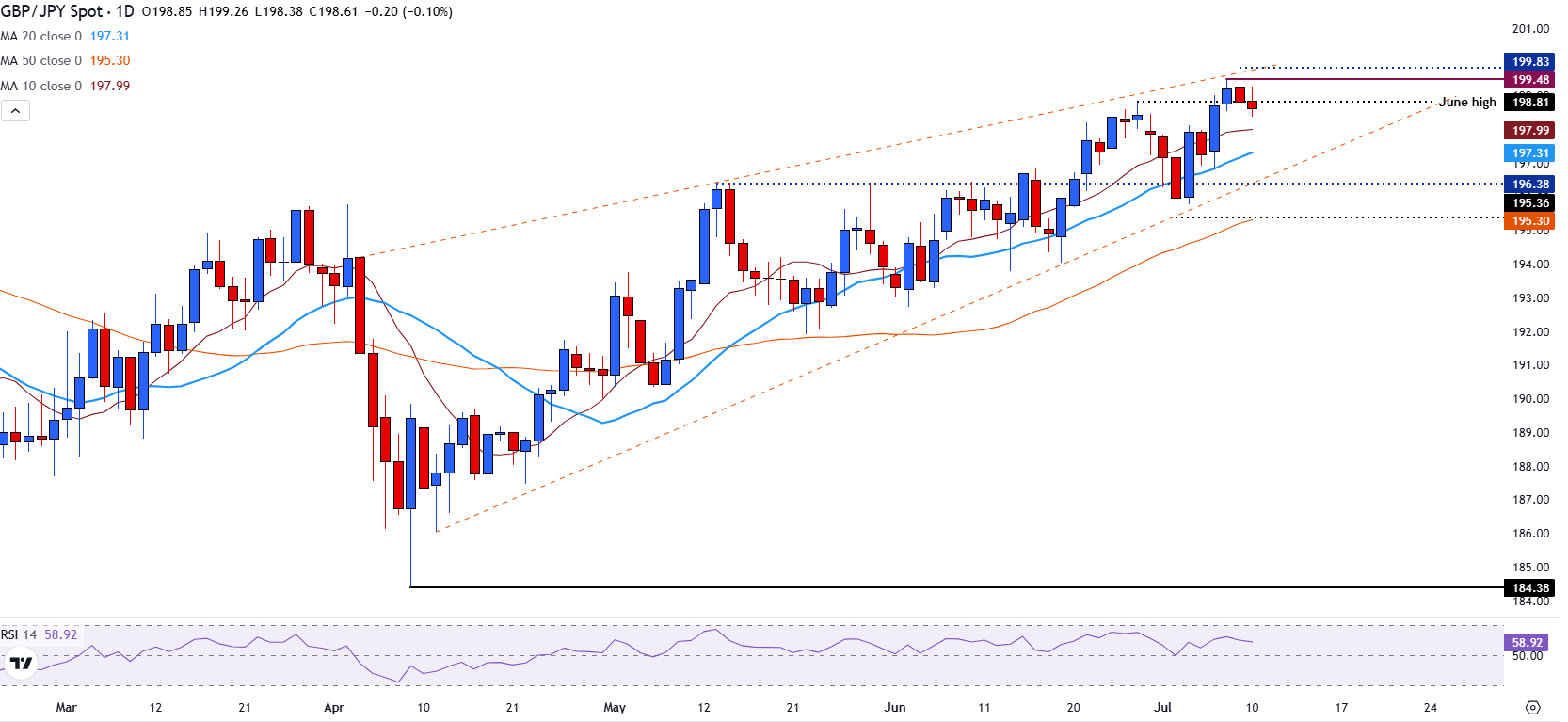- The GDP and production data of the United Kingdom focus on Friday while the concerns about the recession persist.
- The BOJ remains cautious as commercial tensions increase, but the demand for sure shelter provides some relief for the YEN.
- The GBP/JPY goes back below the resistance of 199.00, within the limits of an ascending wedge.
The sterling pound (GBP) is quoted slightly down against Japanese Yen (JPY) on Thursday, since the feeling of risk changes in response to renewed commercial tensions.
After reaching a maximum of several months of 199.83 on Wednesday, the GBP/JPY has retreated, with the price action remaining below 199.00 at the time of writing this report.
The BOJ remains cautious as commercial tensions increase, the JPY is modestly strengthened by defensive flows
Although the Bank of Japan (BOJ) has maintained its interest rate by 0.5% since it increased it in January, policies responsible continue to express concern about the economic impact of US trade tariffs.
In response, the BOJ has maintained a cautious posture about the increase in interest rates, allowing their counterparts to benefit from investors looking for greater returns in their investments.
While this narrative persists, Thursday’s tone in JPY’s price reflects a slight defensive offer.
The GDP and Production data of the United Kingdom in the Focus on Friday as the recession risks increase
Looking forward, the market approach will move to a crucial batch of economic data of the United Kingdom scheduled for Friday.
At 06:00 GMT, the data of the Gross Domestic Product (GDP) of May, the industrial production and the trade balance of goods will be published. These figures arrive at a delicate time for the economy of the United Kingdom, since those responsible for policies evaluate whether the recent weakness is transitory or indicates a broader deceleration.
Consensus expectations indicate a slight rebound in the monthly GDP at 0.1%, after a contraction in April. Meanwhile, manufacturing and industrial production is expected to stabilize after consecutive falls.
A set of disappointing figures, especially if both production and trade do not meet expectations, could reinforce concerns about stagnant growth. Such scenario could lead to speculation about a possible rate cut by the Bank of England later in this quarter.
For the GBP/JPY, the weak data of the United Kingdom could amplify the downward pressure, particularly if it coincides with a defensive positioning before the important geopolitical meetings next week. However, a positive surprise could help to recover the 199.80–200.00 area if the appetite for the risk remains firm.
The GBP/JPY goes back below the resistance of 199.00, within the limits of an ascending wedge
At the time of writing, the GBP/JPY is quoted just below 198.80 after briefly touching the upper limit of an ascending channel earlier this week.

The inability to establish an impulse beyond the psychological brand of 200.00 has caused some benefits, while a modest offer returns to the Japanese and in the middle of a greater geopolitical caution.
Technically, the GBP/JPY par is sailing between family levels. The maximum of June in 198.81 now acts as a short -term support.
A downward movement could see prices to test the simple mobile average (SMA) of 10 days near the psychological level of 198.00 and the 20 -day SMA in 197.32.
Upwards, a movement above the level of psychological resistance of 199.00 and a new test of 199.83 could provide the bulls the opportunity to push prices above the channel resistance in 200.00.
With the relative force index (RSI) reading just below 60, the conditions remain bullish; However, the impulse of the upward trend seems to be weakening.
LIBRA ESTERLINA – FREQUENTLY QUESTIONS
The sterling pound (GBP) is the oldest currency in the world (886 AD) and the official currency of the United Kingdom. It is the fourth most commercialized currency exchange unit (FX) in the world, representing 12% of all transactions, with an average of $ 630 billion a day, according to data from 2022. Its key commercial peers are GBP/USD, which represents 11% of FX, GBP/JPY (3%) and EUR/GBP (2%). The sterling pound is issued by the Bank of England (BOE).
The most important factor that influences the value of sterling pound is the monetary policy decided by the Bank of England. The Bank of England bases its decisions itself has achieved its main objective of “price stability”: a constant inflation rate of around 2%. Its main tool to achieve this is the adjustment of interest rates. When inflation is too high, the Bank of England will try to control it by raising interest rates, which makes access to credit for people and companies more expensive. This is generally positive for sterling pound, since higher interest rates make the United Kingdom a more attractive place for global investors to invest their money. When inflation falls too much it is a sign that economic growth is slowing down. In this scenario, the Bank of England will consider lowering interest rates to reduce credit, so that companies will borrow more to invest in projects that generate growth.
Published data measure the health of the economy and can affect the value of sterling pound. Indicators such as GDP, manufacturing and services PMI and employment can influence the direction of the sterling pound.
Another important fact that is published and affects the pound sterling is the commercial balance. This indicator measures the difference between what a country earns with its exports and what you spend on imports during a given period. If a country produces highly demanded export products, its currency will benefit exclusively from the additional demand created by foreign buyers seeking to buy those goods. Therefore, a positive net trade balance strengthens a currency and vice versa in the case of a negative balance
Source: Fx Street
I am Joshua Winder, a senior-level journalist and editor at World Stock Market. I specialize in covering news related to the stock market and economic trends. With more than 8 years of experience in this field, I have become an expert in financial reporting.







